- CURRENT LOGO TRENDS
Technology Logo Design
Technology minimalist logo design in illustrator Bangla tutorial 2020
by HAMLET HYEDER
LogoLounge.com is the world’s largest logo search engine. For less than $10 per month (billed annually), members get unlimited uploads and access to more than 250,000 logos from designers across the globe. They also get immediate entry into the selection process for the LogoLounge book series. For more information, visit our join page.
Want a PDF version of these trends? Enter your email address below, and we’ll send you a link to the PDF version of this report!
This year's logo trends were influenced by a pendulum shift that's starting to swing from clean, modern aesthetics toward curvy, retro designs that reflect a new attitude through colour and embellishments.
Any time we look at trends, we tend to see that there is a pendulum that is swinging. For instance, it's not uncommon to see an evolution from a flat logo to something dimensional or vice versa. But over the last three years in particular, from a typography standpoint, we've seen a transition toward very austere sans serif logos. Google flipped from a serif font to a sans serif, and other major brands like Verizon, Calvin Klein, and Century 21 did the same.
Part of what's going on here is this idea of clarifying the message and conveying transparency. Unfortunately, it also strips these brands of any personality when it becomes too sterile. However, this year, the pendulum is starting to swing in the other direction as a direct reaction.
When everyone moves to this level of simplicity, designers counter it with some embellishment. Very expressive logos are making a comeback, which is a direct result of nostalgia or reboots. We've seen it played out on the big screen in Ready Player One and on the small screen in Stranger Things. There's a thirst for nostalgia and this hearkening to past decades. Designers are dusting off their old font folders, going back to designs that were popular in the '70s, '80s, and early '90s. Letters with big, expressive serifs, similar to a man having a mustache-it's an added embellishment that changes the viewer's perspective, perhaps recalling a different time period, but done in a uniquely new way, with modern influences. Millennials are most responsible for bringing these trends back into play, and you see it everywhere with the resurgence of tiki bars and speakeasys, and custom products like shaving kits for men. By going backwards, you can pick and choose what you want to bring forward and blend it with contemporary aesthetics. I've seen a lot of brands doing this successfully, and I think it's just the beginning.
Color expectations have also changed dramatically. Because color mostly lives onscreen, there is a greater intensity in color range because it's being projected from a screen. Colours are merging and blending, and gradients are now part of our color dialogue. A lot of this has to do with apps like Instagram—which, in fact, has a gradation as part of its logo. That's an extreme example, because it runs the gamut from yellow to pink to purple, but most gradients are very subtle like red shifting toward red-orange, in essence making a new color. People now recognize gradients as colors. This is a trend that will continue to shift and grow.
All three of these movements work together as nostalgia swings the pendulum through different decades and influences color choice and customization. You'll see a vast array of these examples throughout the report.
It's important to note that trend is not a bad word, and it doesn't equate to trendy, as in here today, gone tomorrow. The logos featured here are on the outer-edge, influencing the next big thing. Much of it is experimental, which ultimately pushes design to the next evolution. We all live by trends—whether it's fashion, food, or design. We like them and we adopt them because they make life more diverse and fun, even as they evolve and change. The key takeaway from this is not to imitate, but to find a way to push these ideas forward and make them your own.
TUMBLED
Much as a tide and time can dull the sharpest corner of stone or random shard of glass, designers are tossing the occasional mark into the wash for one last tumble before presenting to clients. This is a bit like over-easing the edges before handing off a newly minted bobble to a child. Guaranteed, there will be no eyes poked out in the handling of these logos. The key phrase here is not easing, it's over-easing. There is a certain level of finish that occurs when knocking back a sharp corner, but in over-amplifying the effect, designers are delivering an entirely different message.
A friendlier, more approachable mark is crafted, but by applying this effect, the designer assures the consumer a certain level of implied simplicity. The mark represents a process, product, or service that's been tested and worn in to remove any unfriendly burrs. Simplicity of initial design is imperative as a starting point, and you may notice most of these are a single-color solution. Reduction of tumbled logos never create screen challenges as a computer's process of simplifying detail has already handled it. As friendly as these are to consumers, clients should have reasoning in mind when asked, “Why so round?" How much you should ease a corner can be like the fine line between a healthy tan and someone who's over-baked on the tanning bed.
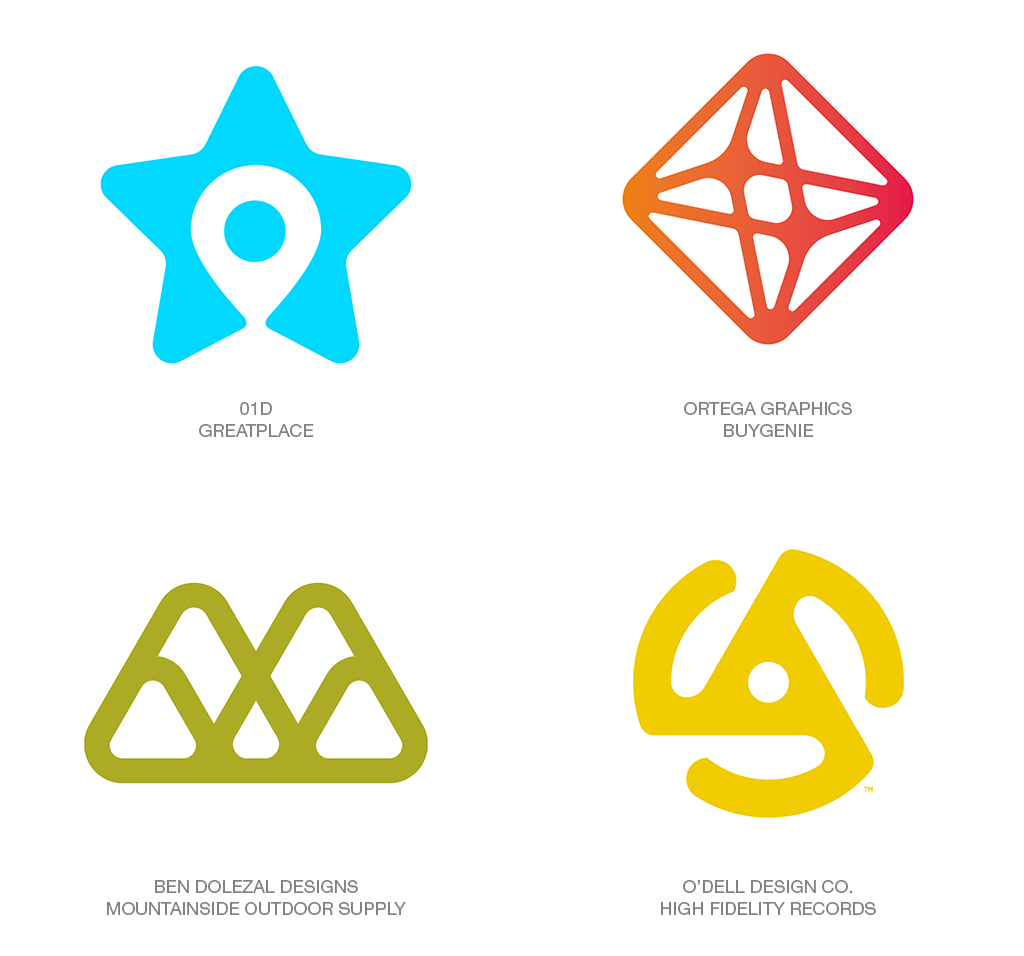
PARALLELOGRAM
One of the tenets of logo design is that forward motion means up and to the right. It's the direction you want your investments, or your production to take if you're looking at a graph. It's the difference between gazing up to the future or glancing back at the past. So, what a surprise to discover a flurry of up and to the right parallelograms littered throughout this year's field of work. And though the symbolism is not unexpected, the sheer number of them is. And the puzzlement of this discovery is only matched by the diversity of applications.
The nature of the oblique shape gives it a sharp, aggressive attitude. An element captured in motion and perfect in form to serve as a vehicle for type or as a passenger to accent a larger message. Note the parallelogram in the lead role with Carling or as a demure accent on the "i" in Stripe. Or taking on a number of configurations to speed other solutions to the fore. A remnant of Spartan attitude remains in this trend that leaves no home for embellishment. All of these are clean, to the point solutions that signal "up and to the right" as their clients' mantra.

OUTLINE
It's easy to muse that master sports logo designers may lose credentials and peer respect if they ever released a mark without encasing it in a wide gray outline. How else would we know it was for a team? This may or may not be the influence at work, but over the last year, we've seen an uptick of logos with absolutely no sports affiliation tightly ensconced in their own mono-weight outline. An astral aura if you will, exuding a rich karmic energy.
Drawing attention with a highlight outline in most of these cases adds a nice touch or serves a functional purpose, but you have to ask to what end. It may imply a team essence to the entity or much as sports logos, it may be designed to allow the image to work on both light and dark color fields. Note that the Acid Pineapple actually has a double aura. A better hunch is it's a stylistic pop of embellishment that allows an otherwise unremarkable mark to capture additional attention and project a bit of its own graphic energy.
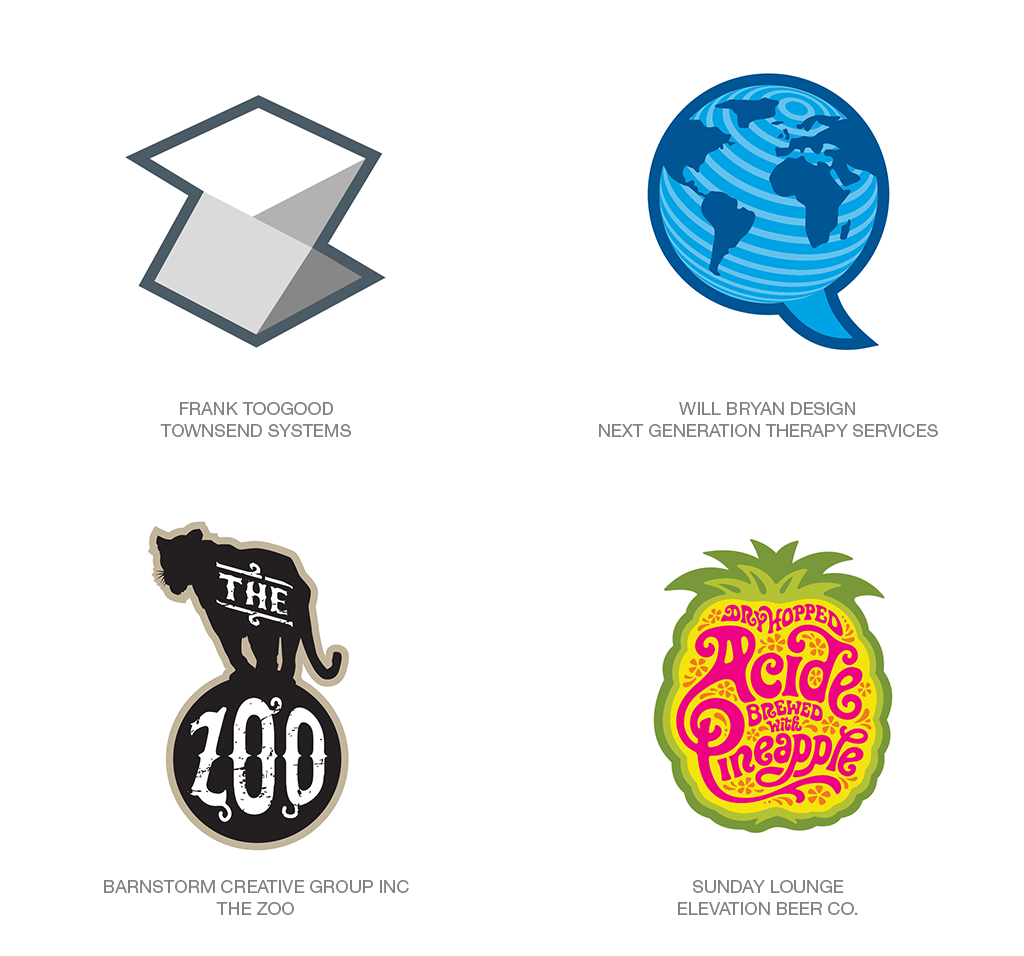
MODERN RELIGION
Let's start by recognizing the works in this trend are not going to be seen representing anything more than a designer's folio site. They might appear on a couple of great T-shirts or a band's drum kit as well, but more than anything, these logos tend to reinforce the design fraternity's infatuation with rich symbolism. These stars, jewels, hearts, arrows, and skulls are so entrenched in the lore of secret societies that their very essence reeks of mystic ritual. Either that or naivety blinds us to an underground designer cult with secret passcodes and a handshake.
From a design standpoint, these explorations are beautiful to view and demonstrate how a crafty designer can build an aesthetic fortress from completely vacuous elements. Exercising our design chops on fantasy projects is not completely bereft of value, though. This group has elegance of execution and each could, for example, represent another topic altogether after exchanging a moon, a hand, and a sword for a couple of roosters, a pig, and a chef's hat.
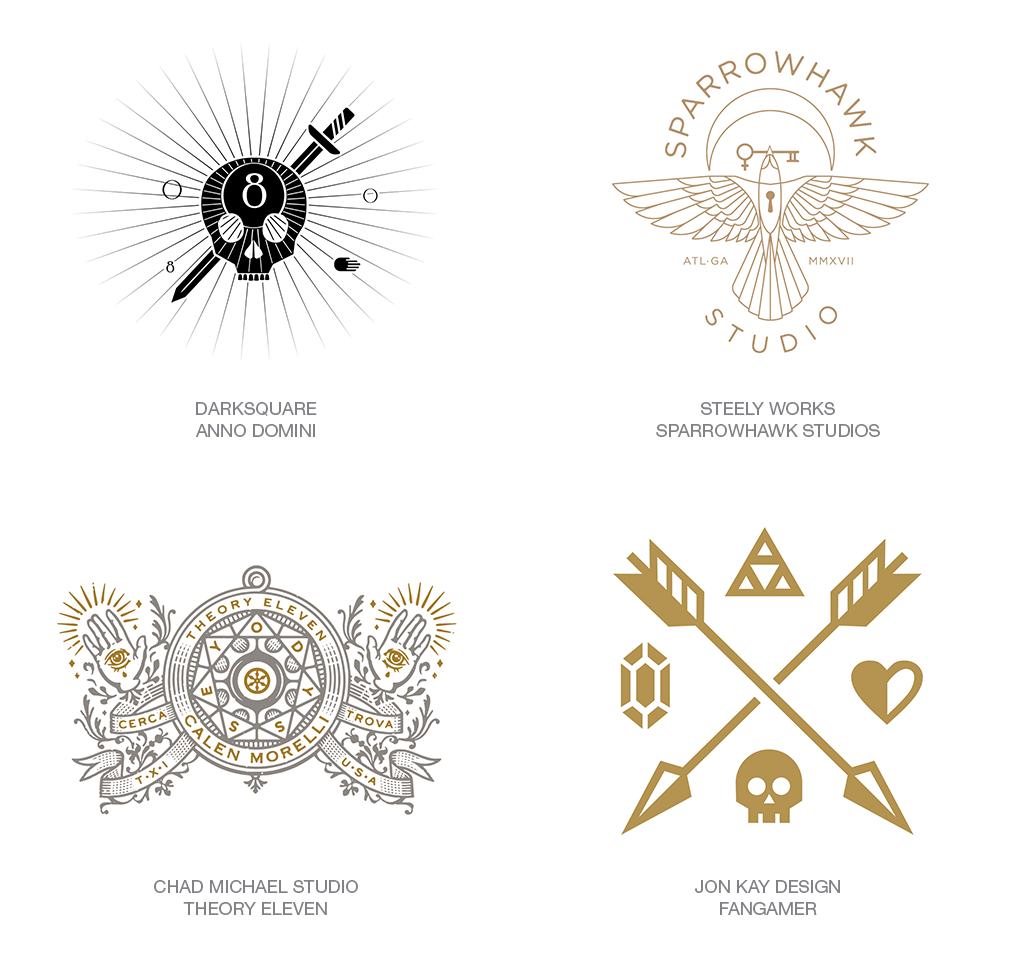
NEO VINTAGE
In a common thread, designers are retreating this year to a number of themes drawn from past influence. Which is not too dissimilar from the movies only generating sequels and remakes. There's certainly a level of guilty pleasure involved in turning back the nostalgia dial, but such efforts seldom create advances in our craft. Whether born as an antidote to put the brakes on a fast-paced counter movement or to fill the time while we give serious thought to where we go from here. We must also consider these forays into the past as a revisit for an older generation, but as a first-time trip to the more recently minted designers.
Imagery that was plucked from the last century seems to be fair game here. A wink to Mid-Century Modern is still popular, as is the reboot of ad mascots and characters of the same era. Note that many of these examples blend a typographic solution with a primary image, much as other badges we are looking at in this report. A noticeable marking tag for this group may be the placement of a primary typographic solution or wordmark plopped dead center on top of the supporting image. Fun, light-hearted, and well-crafted but with the gravitas of a romance novel.
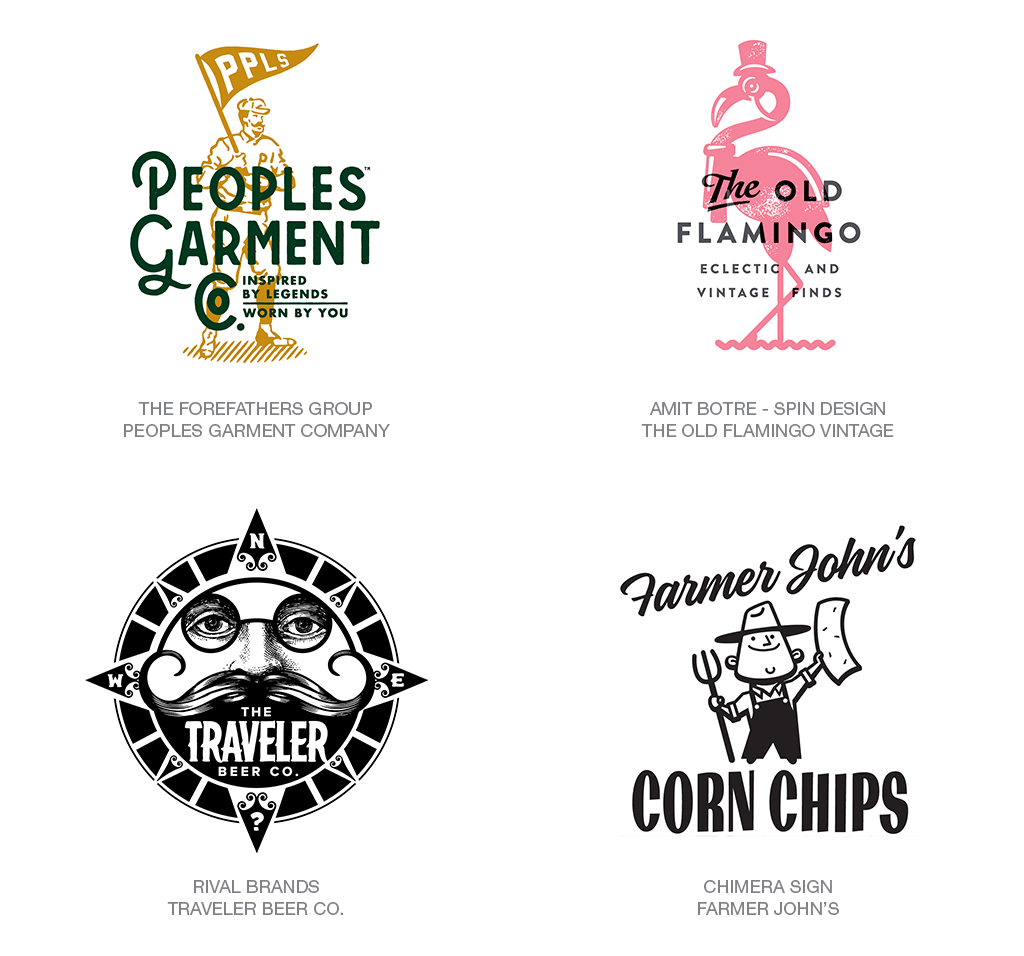

B/W HIPSTER
Hipsters, by their very definition, shun status quo and embrace an alternate perspective. This category first started to define itself several years ago as stock elements became available online actually marketed as Hipster Badges. As we discuss this trend, it would be fair to ask if the hipster is the designer or the target of the solution. Fortunately, this direction has matured by advancing beyond the crossed arrows, flowing casual scripts, and other clichés that originally defined the set.
These logos do a smart job of targeting this group by combing otherwise traditional components in a counter traditional way. Generally, the marks are void of color as our trend name suggests, but rich in detail. The style is a nod to monoline construction adopted over the last decade. It's not uncommon to see these marks used to represent entities with a vibe, or culture that feels comfortable with a reference to the past but with a spin that defines the next generation at a glance.
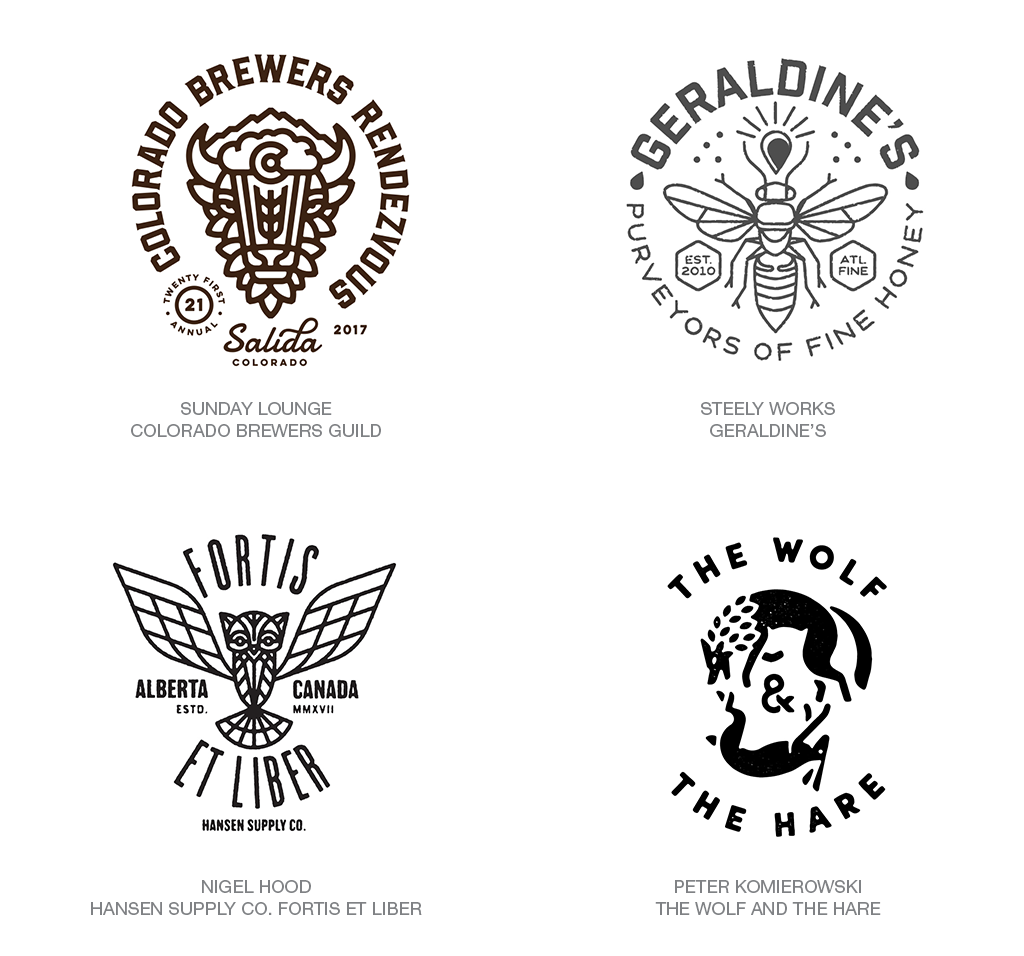
EST TRD MRK
A deeper dive into our exuberant infatuation with badges has to touch on the use of the big three, established, trade, and mark. That quintessential balance created by clustering letters, numbers, and graphics has come to rely on some convenient abbreviating that leaves wordsmiths wriggling with pangs. Like a set of scales requiring adroit attention to level them, designers weigh out three letters on the left and three on the right. Does that mean a four-digit date on the right needs a four letter ESTB on the left? And most important, if you use TRD MRK for trademark, will consumers read TRD phonetically?
Our infatuation with the creation of implied heritage really deserves greater attention than these two paragraphs allow. The new culture of small shoppe business and personal attention are fiercely fighting the truly established bluebloods for the same share of consumer attention. Heritage that's only inches deep is winning through smart design, even when the identity reads ESTB 2018.
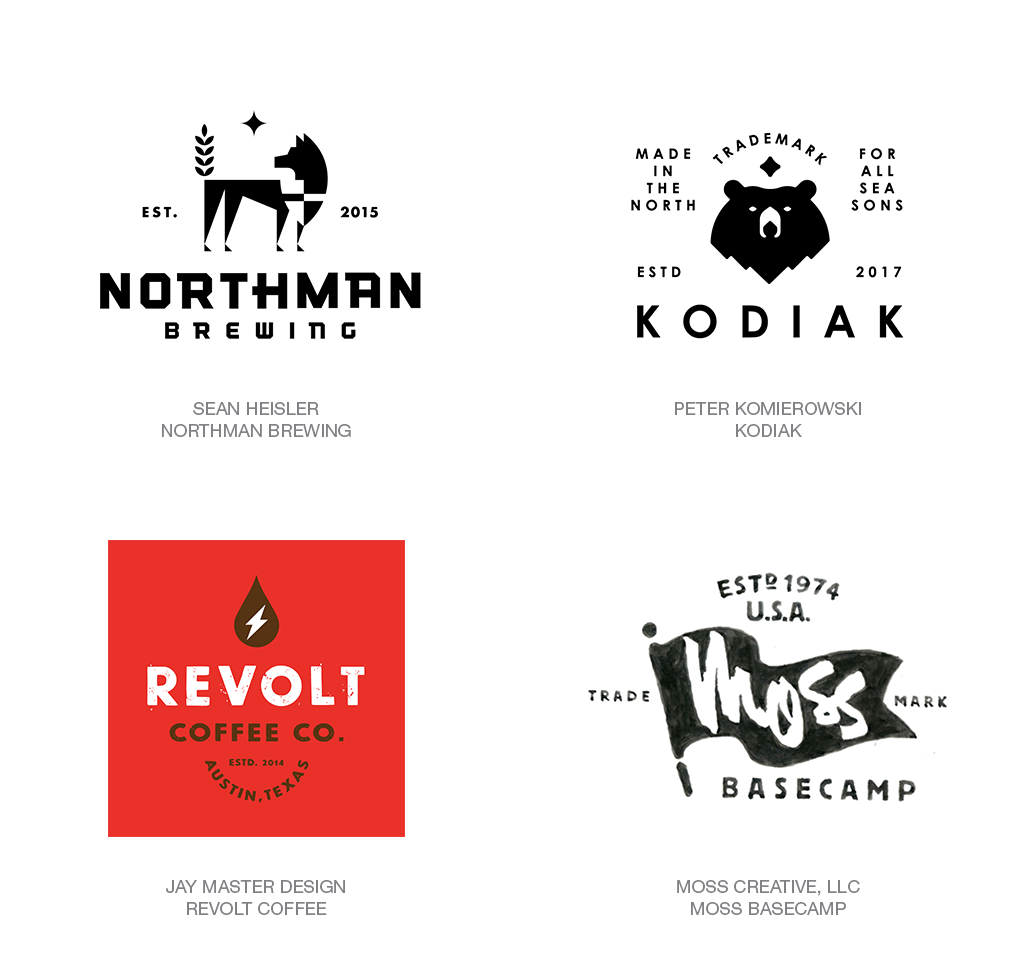
BLURPLE
Gradation in logo design is nothing new. Extreme eye-popping, chroma-screaming applications like Instagram continue, but the trend here is the adoption of subtlety. Dropping a field of color onto a mark that could easily be solid black, blue, or purple. But how about a gentle almost sub-existent transition of hue? A blue field that ticks a notch or two more purple, or a magenta that drops from a 100 percent intensity to 80? These are the new spectrums that are expanding the thinking in branding and color affiliation.
The time when T-Mobile owned magenta or FedEx owned orange and violet, is shifting to Belfast owning yellow creeping to a yellow orange. These are tight and short-run gradients that might initially give the impression half the logo is just poorly lit. These gradients can indicate a transition or a process and are made practical by a societal shift toward the RGB dominion of digital screens. Blurple is no longer that color halfway between blue and purple; it is the trek between the two.

GOLD
That cringe associated with a client suggesting they'd like their logo in gold has been replaced by the designer suggesting the same back to the client. The afore mentioned embrace of subtle gradation has led to a swell in the number of marks rendered with their own glint of faux bullion. While the option of foiling a mark or utilizing metallic inks are both traditional solutions for such a dilemma, neither solution translates to the screen. Our industry has seen the importance of digital imagery rocket past the secondary print materials in the last decade, but note this as an evident shift in who has the car key.
Gold still conveys everything it always has, it just has a better agent working for it. Flexibility in rendering is still abundant. If you want a flat gold, go for it. If you want a sheen, do you want it flat or textured as in the letter B monogram? Or, since you're digital, maybe you want a gentle wash of light across the logo with a lens flare and a ping at the end. Let's hope not. Gold, used properly, still carries a 14K level of prestige, elegance, and sophistication like no other color. It's a color the public expects, the application is not.
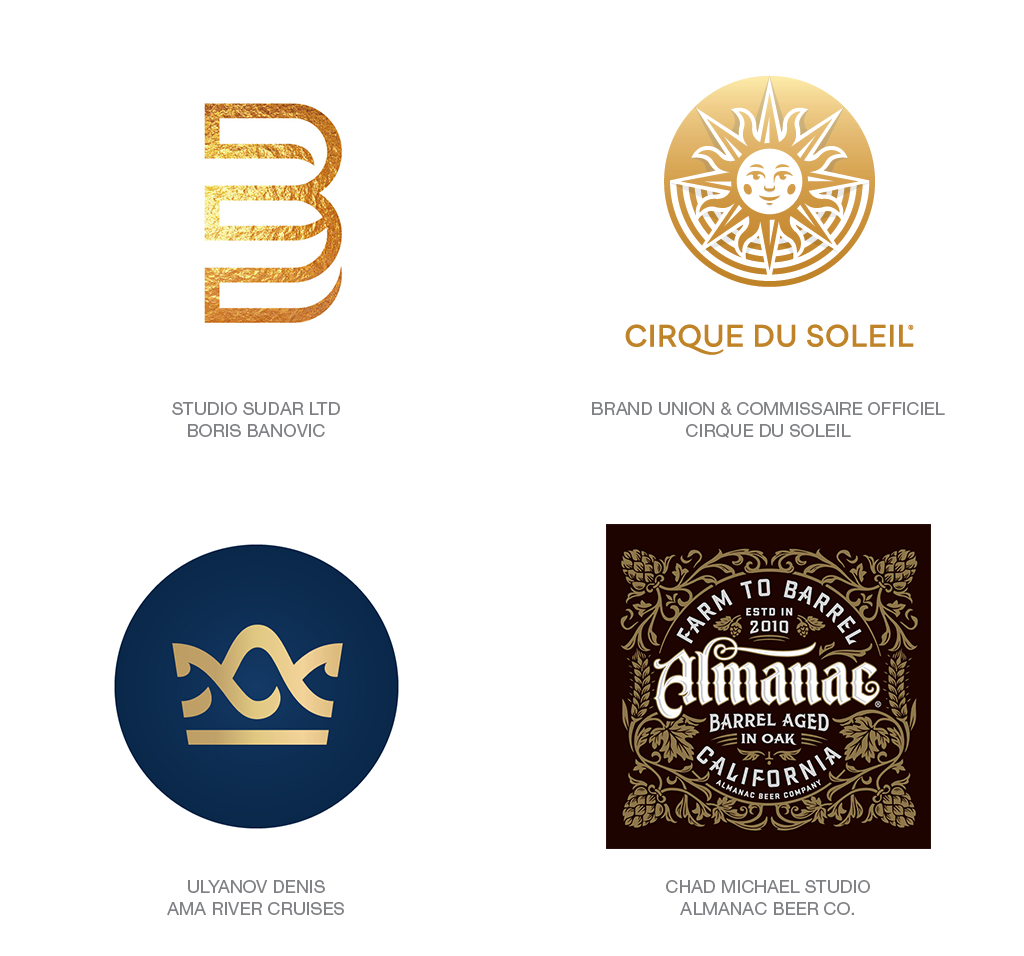
FATTY FADE
Smart designers understand that the past and the future are inextricably connected and that if you're clever enough, you'll call your appropriation a discovery. The seminal textile design of Verner Panton in 1971, launched an era of wall art and carpets that swayed, curved, and zagged with concentric stripes of vivid, stepped colors. Saul Bass notably used the same effect many times to smart success in the '70s, including the brilliant Paul Harris Stores logo. Though similar to the ombré trend of the 2016 report, the momentum here is with strong stepped geometry.
This is an analog gradient that's fresh and vibrant to a new generation of eyes with a hint of retro for a kicker. Aaron Draplin has done as much as anyone to rekindle this genre with a more contemporary aesthetic to its application. The resurgence comes with invigorated thinking and applications that blend the stripes with diverse elements that make for much richer solutions.
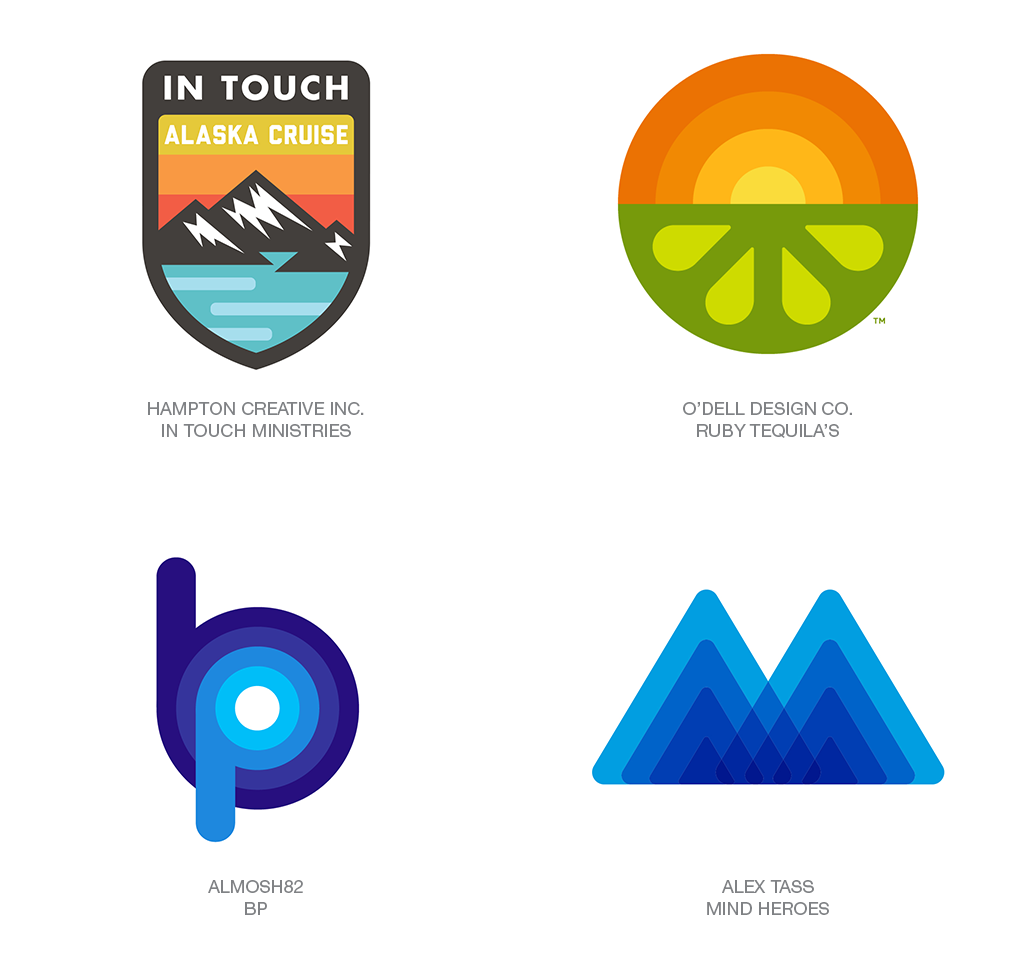

LINEAR FADE
Some trend reports are filled with more nuances than others, but they are here for a reason. What may seem like modest variants on a theme to one, look like significant departures to others? Linear Fades carry much of the same attribution and history as Fatty Fades with a significant mutation. Our stepped gradient effect is divided by channels that reflect a marriage and offspring from our stripped theme last year. A discreet variant, but an important one, as this evolves.
Because of the channels, these marks appear much more grounded and don't exhibit the same flood of intense color found in Fatty Fades. Channels may equal the width of the stripes or they may thin down significantly. It's easier to envision this group of logos in a corporate climate, but with the right colors they still radiate a stylish level of optimism. Note that the simpler the design the more effective these read. Adding channels doubles the complexity of any design so brevity of strokes is essential.
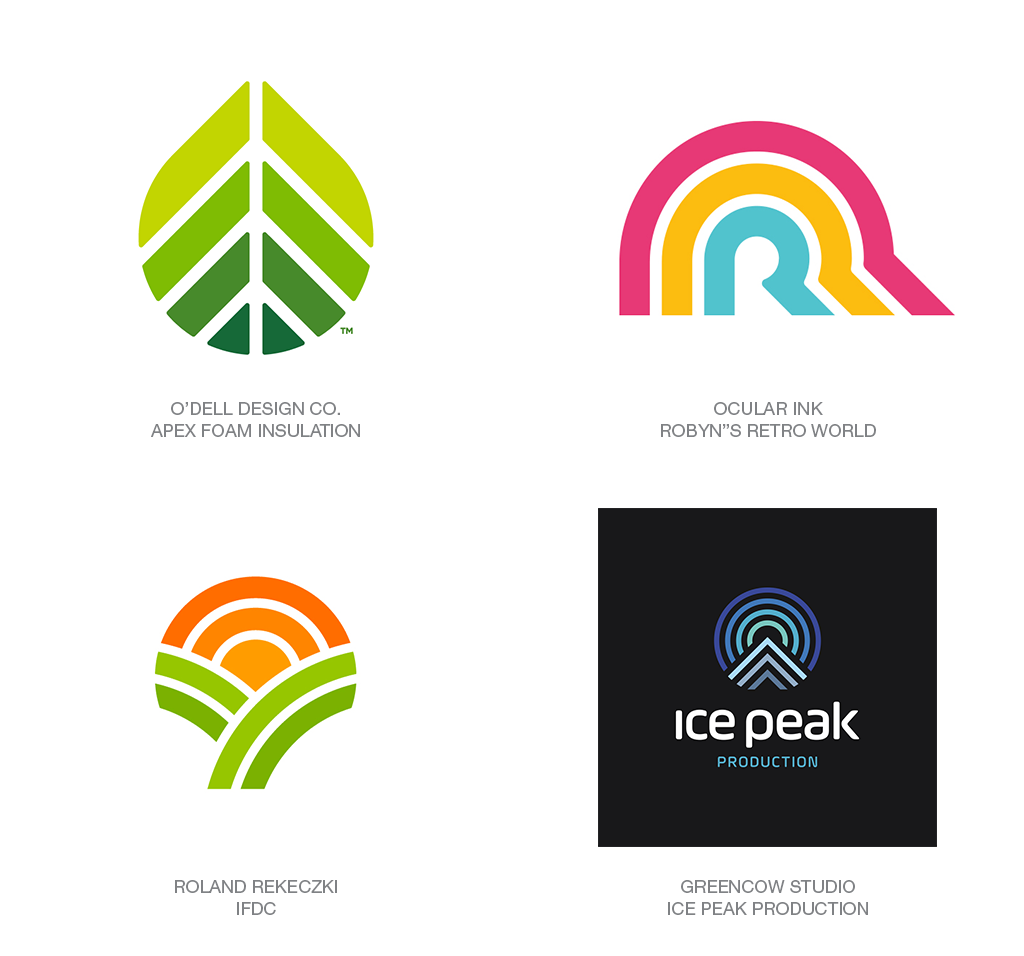
FIELD LINES
Big, fat, burly Kevlar-plated line work is what happens when traditional monoline design starts bulking up for its next role in Logo the movie. Any assumption you'd escape this report without yet another evolution of the monoline aesthetic is wrong. Once, this fine outline started as the antithesis to areas of tone by describing perimeters as opposed to content. Now these lines are tipping the scale with a girth that's turned the line into a field of its own. Frankly, it's a good look as the faint haze of linework reduced has now been replaced by a bold undeniable mark reminiscent of past works that launched the golden era of logos.
Now, instead of squirming that the linework won't stand up to reduction, we might find ourselves concerned the negative space is too fine to do the same. Loading up these marks with fields of color may be gilding the lily, which is why many of them don't even try. The lines on these marks still maintain a consistent weight that continues to convey a measured, technical aesthetic. Finding the weight that creates a balanced contrast allows these to read well at a distance or when squeezed down for micro application.

CUT
We tend to take our letterforms pretty seriously, and I'm not just referring to designers. Ask any type maven and they can regale you with just how much leeway the public is willing to allow when crafting a font. Embellish a letterform, and you're just improving; but remove a stroke here or there, and you'll be issued a cease and desist notice without apology. The designers of the marks in this trend are just flat flaunting their disrespect, and in doing so have captured the attention of the consumer.
A judiciously excised aspect of a word or letterform may create no issue with legibility. We folk are a pretty clever lot when playing fill in the blank. But what we edit out can be either a vacuous stylistic gesture or a clever treatment to reinforce a message or help provide context for a brand. The latter is certainly preferred. With Slate's new wordmark, the A is no less legible, and it helps convey the journalistic editing and overlapping of content that's a part of their process. When crafted with wit and prudence, these solutions earn honors in disruption 101.
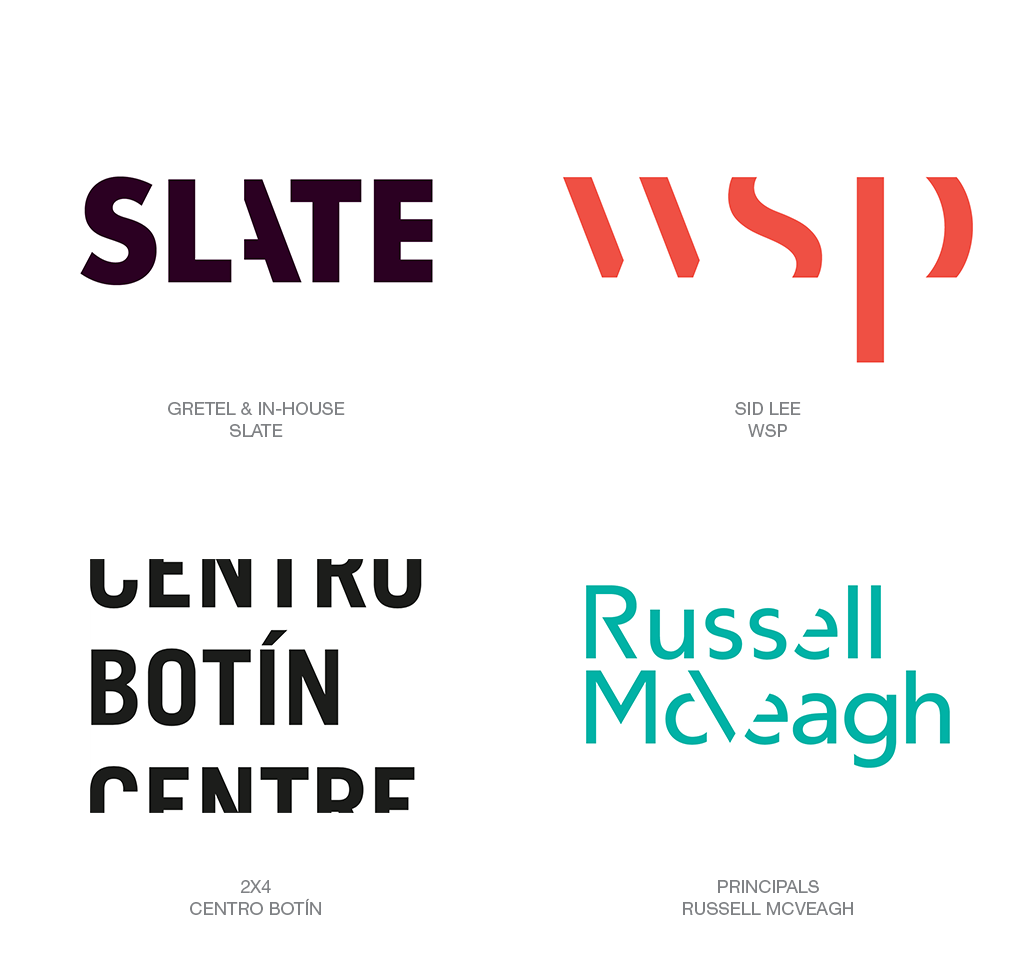
SERIF REDUX
Picture a cycle of rebrand austerity that found many of the most beloved brands racing for the anonymity of soulless sans serifs. Such a flood of willing participants in this still bleeding, but waning trend, that an action of descent speaks louder than sans. Maybe it was a crop of nascent designers prepping to binge the freshly hyped Stranger Things, and looked at the title graphic, mouth agape, at the entrancing serifs hanging from each and every letter. A throwback for sure, but the cultural impact of this show can't be denied. It may well have led to the largest mass migration of designers in history, as they scrolled through their font files and were reunited with long-lost serifs.
The rebrand of Chobani at the leadership of Leland Maschmeyer, brought warmth, humanity and unapologetic charm to a product previously lingering behind a futuristic sans serif. In logo design, many of the trend-countering serif, signal a return to a period when a little fat and curve on the bones was a good thing. The resurgence also welcomes back lowercase solutions to the tent that was starting to feel pretty empty. Nature abhors a vacuum and designers do too.

PUNCTUATION
Logo design is such a succinct practice exactly because a mark has to completely speak for itself. There's no room to attach a preamble or an explanation as a sidecar on a symbol. Yet the last year has been notable for the refresh and creation of numerous brands punctuated into an alternate state of meaning. Linguaphiles may be simultaneously cringing and cheering their support, depending on the application, but planting a fleck or a speck at the end of a name is much more than a stylish affliction. These periods, commas, colons, and more are opening a previously unconsidered dialogue with consumers.
Though Redbox is not a sentence, it is determined to drop the mic with a period, capping out any additional discussion. That is all there is to say. The publication Darling, sets the stage for what's to come with the perfect use of a comma. Like the opening of a letter, the publication both greets the reader and prepares them for what's to follow. The inc. in Winc. may well have been lost on the consumer with the two-color split, but the period at the end of the abbreviation of “incorporated," makes it evident. Punctuation is a trend that has its place, but there's reason to fear it could lose good standing with rampant misuse.

ABOUT THE 2018 LOGO TREND REPORT
2018 marks the 16th year of this report and again offer us the opportunity to literally review thousands upon thousands of logos one at a time looking for the nuances and artifacts of emerging trends. As we acknowledge that each design represents hours and hours of thought and struggle from designers around the world, we are as humbled and awed as ever by their dedication to the craft and grateful for the important role they play in helping us create these reports. So thank you to all of the designers who have and will contribute to the Trend Reports then, now, and for years to come. A special thanks to that group of designers we lean on for their personal observations and guidance included here within.
For an even deeper look at this year's trends, visit our learning course on LinkedIn Learning (formerly Lynda.com).
Bill Gardner is the president of Gardner Design and founder of LogoLounge.com, a repository site where, in real time, members can post their logo design work and search the works of others by keyword, designer's name, client type, and other attributes. The site also offers articles and news written expressly for logo designers and much more. Bill can be contacted at bill@logolounge.com.
LogoLounge.com is the most comprehensive and searchable database of logos available today. More than 272,000 logos have been submitted to the site since 2002, growing it to the largest online treasury of professionally designed logos. Through their submissions, members also gain the benefit of consideration for publication in the LogoLounge book series, the best selling graphic design books series in the world.
Through the line of LogoLounge books (currently published in volumes 1 through 10, designers can gain even more insights from a collection of the smartest logo designs submitted to LogoLounge from all over the world and hand-selected by a prestigious team of some of the most respected names in the industry.
In 2016, LogoLounge took a giant step forward as it extended membership to the next generation of designers with LogoLounge Leap, which allows educators and students free or deeply discounted access to the site as well as online resources and educational tools.
For more information on membership and identity design news, visit LogoLounge.com.
Want a PDF version of these trends? Enter your email address below, and we’ll send you a link to the PDF version of this report!
Like what you see? You, too, can join our tribe of quality designers and marketers who continue to make their mark by utilizing the invaluable resource that is LogoLounge.com.
Click to get more information and join the LogoLounge Community!
Click to get more information and join the LogoLounge Community!










0 Comments